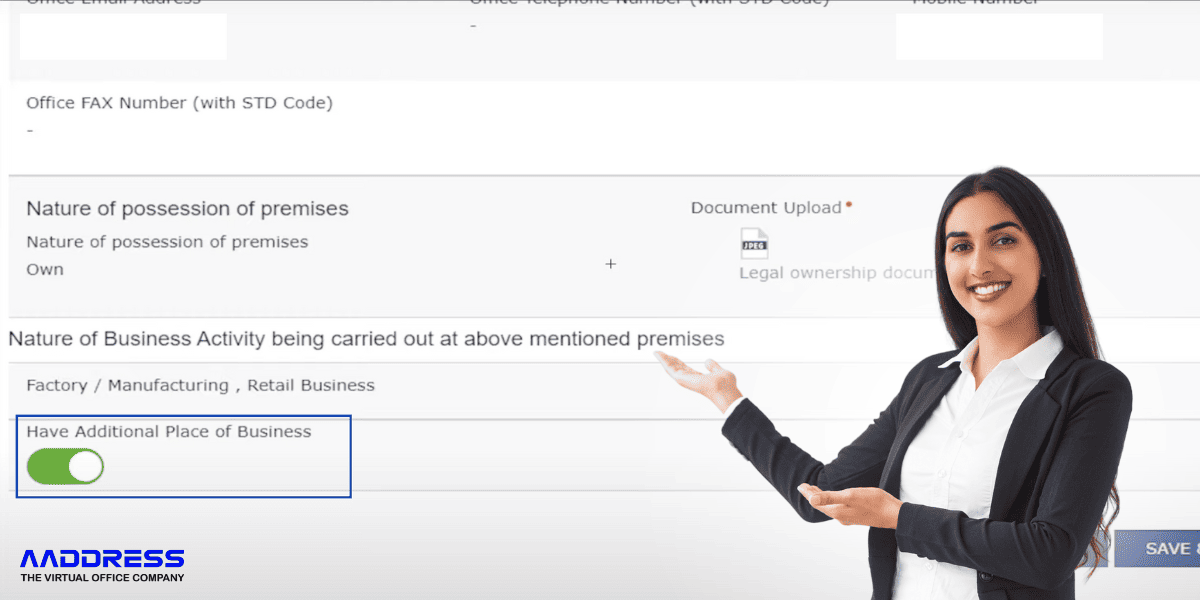Don’t just get a virtual office—let us help you build your business with our expert resources.Learn More
How to Start a Drop Shipping Business in India

Highlights:
-
- The Indian dropshipping market size is estimated to be around $1 billion currently and is expected to grow at a CAGR of 25% in the next 5-7 years, reaching $5 billion by 2028.
- The overall Indian e-commerce industry is projected to reach $300 billion by 2030, demonstrating the immense growth potential for dropshipping businesses.
- The fashion and apparel segment in India is a particularly lucrative market for dropshippers. The apparel market revenue in India is projected to reach ₹8.76 trillion ($107 billion) in 2024, growing at 4.23% annually.
- The broader fashion market in India is expected to reach ₹1.22 trillion ($15 billion) in revenue by 2024, growing at 11.11% annually.
- Approximately 27% of Indian retailers have chosen dropshipping as their primary order fulfillment method, and third-party logistics providers are expected to manage around 17 billion shipments in India within the next 7 years.
Source Credit: https://www.youtube.com/@ombaraiya27
Introduction
Starting a dropshipping business in India can be a lucrative venture given the country's booming e-commerce market and the increasing accessibility of digital tools and platforms.
Dropshipping, a retail fulfillment method where a store doesn't keep the products it sells in stock, allows entrepreneurs to sell products directly to consumers without holding inventory. This model minimizes risks and upfront costs, making it an attractive option for many aspiring business owners.
In this comprehensive guide, we will walk you through the essential steps to start a successful dropshipping business in India.
We’ll cover everything from understanding the dropshipping model and conducting market research to setting up your online store and marketing your products.
Understanding the Dropshipping Model
Before diving into the practical steps, it's crucial to grasp the fundamentals of dropshipping:
How It Works:
When a customer places an order on your online store, you purchase the product from a third-party supplier who then ships it directly to the customer.
Advantages:
Low startup costs, no need for inventory management, flexible location, wide product range, and scalability.
Challenges:
Lower profit margins, dependency on suppliers, longer shipping times, and customer service issues.
Steps to get Started
Step 1: Conduct Market Research
Identify Your Niche: Selecting the right niche is crucial for the success of your dropshipping business. Consider the following factors:
Passion and Interest: Choose a niche you are passionate about to maintain motivation.
Market Demand: Use tools like Google Trends, Keyword Planner, and social media platforms to gauge market demand and trends.
Competition: Analyze your competition to understand their strengths and weaknesses. Tools like SEMrush and Ahrefs can help in competitor analysis.
Validate Your Niche:
Customer Feedback: Check online forums, social media groups, and product reviews to understand customer needs and pain points.
Profitability: Ensure the niche has products with a good profit margin. Generally, aim for a profit margin of at least 20-30%.
Step 2: Find Reliable Suppliers
Finding reliable suppliers is critical as they are responsible for product quality and shipping. Here are some ways to find suppliers:
Indian Suppliers:
Indiamart: A leading B2B marketplace connecting buyers with suppliers.
TradeIndia: Another B2B portal for finding Indian suppliers.
Local Manufacturers: Directly approach manufacturers in your niche.
International Suppliers:
AliExpress: Popular for dropshipping with a vast product range.
Oberlo: A marketplace integrated with Shopify, providing access to numerous suppliers.
SaleHoo: A directory of vetted suppliers offering products across various niches.
Evaluate Suppliers:
Product Quality: Order samples to assess product quality.
Shipping Times: Ensure reasonable shipping times and reliable delivery.
Communication: Test the supplier's responsiveness and communication skills.
Reviews and Ratings: Check reviews and ratings from other dropshippers.
Step 3: Set Up Your Online Store
Setting up an online store involves several steps, from choosing a platform to designing your store and listing products.
Choose an E-commerce Platform:
Shopify: A user-friendly platform with extensive dropshipping tools.
WooCommerce: A customizable WordPress plugin suitable for those with technical skills.
BigCommerce: Another robust platform with various integrations and features.
Design Your Store:
Domain Name: Choose a unique and memorable domain name that reflects your brand.
Theme and Layout: Select a clean, professional theme. Ensure your site is mobile-friendly.
Branding: Develop a strong brand identity with a logo, color scheme, and consistent imagery.
Add Products:
Product Listings: Create detailed and appealing product descriptions. Use high-quality images.
Pricing Strategy: Set competitive yet profitable prices. Consider all costs, including product cost, shipping, and taxes.
Categories: Organize products into categories for easy navigation.
Payment Gateways:
Local Options: Integrate popular Indian payment gateways like Razorpay, Paytm, and Instamojo.
International Options: Consider PayPal, Stripe, and other global payment processors.
Step 4: Implement Effective Marketing Strategies
Search Engine Optimization (SEO):
Keyword Research: Identify relevant keywords using tools like Google Keyword Planner.
On-Page SEO: Optimize product pages with meta titles, descriptions, headers, and alt texts.
Content Marketing: Start a blog to drive organic traffic. Write about topics relevant to your niche.
Link Building: Earn backlinks from reputable websites to improve your site’s authority.
Social Media Marketing:
Platforms: Focus on platforms where your target audience is most active, such as Facebook, Instagram, and Pinterest.
Content: Create engaging content, including posts, stories, and videos. Use hashtags strategically.
Advertising: Utilize social media ads to target specific demographics. Facebook Ads and Instagram Ads can be particularly effective.
Email Marketing:
List Building: Collect email addresses through sign-up forms and lead magnets.
Campaigns: Send regular newsletters, promotional offers, and personalized recommendations.
Automation: Use tools like Mailchimp or Klaviyo for automated email marketing campaigns.
Paid Advertising:
Google Ads: Run PPC campaigns targeting relevant keywords. Use Google Shopping ads for product-specific promotions.
Retargeting: Implement retargeting campaigns to reach visitors who didn’t convert on their first visit.
Influencer Marketing:
Identify Influencers: Partner with influencers in your niche to promote your products.
Collaboration: Offer free products or commission-based deals for influencers.
Step 5: Manage Orders and Customer Service
Order Fulfillment:
Automate Processes: Use e-commerce platforms that integrate with your supplier for automated order processing.
Tracking: Provide customers with tracking information to keep them informed about their order status.
Customer Service:
Support Channels: Offer multiple support channels, including email, chat, and phone.
FAQs: Create a comprehensive FAQ section to address common queries.
Returns and Refunds: Establish clear policies for returns and refunds. Ensure a hassle-free process for customers.
Inventory Management:
Stock Levels: Regularly monitor stock levels with your suppliers to avoid stockouts.
Product Updates: Keep your product listings updated with the latest information and stock availability.
Step 6: Analyze and Optimize
Performance Metrics:
Sales Data: Analyze sales data to identify trends and top-performing products.
Traffic Sources: Use Google Analytics to understand where your traffic is coming from.
Conversion Rates: Monitor conversion rates to identify areas for improvement.
Continuous Improvement:
A/B Testing: Test different elements of your website, such as product pages, call-to-action buttons, and ads.
Customer Feedback: Collect and analyze customer feedback to improve your products and services.
Market Trends: Stay updated with the latest market trends and adapt your strategies accordingly.
Step 7: Scale Your Business
Expand Product Range:
New Suppliers: Partner with additional suppliers to offer a wider range of products.
Custom Products: Consider introducing custom or branded products to differentiate yourself from competitors.
International Expansion:
Market Research: Conduct research to identify new markets with demand for your products.
Localization: Adapt your website, marketing, and customer service to cater to international audiences.
Automation and Outsourcing:
Automate Tasks: Use automation tools for order processing, email marketing, and social media scheduling.
Outsource: Delegate tasks like customer service, content creation, and SEO to professionals.
Conclusion
Starting a dropshipping business in India is a feasible and potentially profitable business with the right strategy and execution. By understanding the dropshipping model, conducting thorough market research, finding reliable suppliers, setting up a professional online store, and implementing effective marketing strategies, you can build a successful dropshipping business.
Remember to continuously analyze and optimize your processes and be prepared to scale your business as you grow.
By following this comprehensive guide, you'll be well-equipped to embark on your dropshipping journey and take advantage of the opportunities in the booming e-commerce landscape of India. Happy dropshipping!
Subscribe To Our Newsletter
Conquer your day with daily search marketing news.
Most popular Blogs
Top 5 Locations in Delhi to Set Up Your Virtual Office
When you start a business in Delhi, there's always that one uncle or friend who...
Read Full ArticleReading Time: 5 min.How to Start Water Bottle Business in India: A Practical Guide
Starting a water bottle business in India can be a smart and rewarding move. ...
Read Full ArticleReading Time: 4 min.How to Add Additional Place of Business in GST Online (2025 Guide)
Adding an additional place of business in GST is mandatory for each business if they...
Read Full ArticleReading Time: .Low-Cost Business Ideas with High Profit
Introduction Starting your own business is becoming a popular choice for many people today....
Read Full ArticleReading Time: .



